Python中的fcntl和ioctl系统调用
要控制文件和io,我们应该使用fcntl模块。它基本上是fcntl()和ioctl()Unix例程的一个接口。
此模块中的所有方法都将一个整数或io.IOBase文件描述符作为其第一个参数。
要使用此模块,我们应该使用导入它。
import fcntl
fcntl模块中有一些模块,它们是-
方法fcntl.fcntl(fd,op [,arg])
此方法用于使用文件描述符对文件执行操作。该操作由op定义。第三个参数是可选的。它可以是整数类型值或字符串类型值。当参数为整数类型时,返回值将为Cfcntl()调用的值。如果是字符串,则表示二进制结构。当此函数失败时,它将引发IOError。
方法fcntl.ioctl(fd,op [,arg [,mutate_flag]])
该方法与该方法相同fcntl(),但是在这种情况下,参数处理更为复杂。在参数中,如果传递了可变缓冲区,则其行为将取决于mutate_flag。如果为true,则缓冲区可以是可变的,否则它将充当只读缓冲区。
方法fcntl.flock(fd,op)
此方法用于使用file_descriptor对文件执行锁定操作。在某些系统上,可以使用fcntl()方法模拟此方法。
方法fcntl.lockf(fd,operation [,length [,start [,whence]]])
此方法用作锁定调用的包装器。传递operation参数以锁定或解锁文件。有不同的运算值。
LOCK_UN-解锁文件
LOCK_SH-共享锁
LOCK_EX-排他锁
范例程式码
import fcntl, os, timecounter_file = 'my_counter.txt'
if not os.path.exists(counter_file):
counter_file = open('my_counter.txt', 'w')
counter_file.write('0') #Store 0 as starting number
counter_file.close()
for i in range(15):
counter_file = open('my_counter.txt', 'r+')
fcntl.flock(counter_file.fileno(), fcntl.LOCK_EX)
count = int(counter_file.readline()) + 1
counter_file.seek(0)
counter_file.write(str(count))
counter_file.close()
print('Process ID: ' + str(os.getpid()) + ', Count: ' + str(count))
time.sleep(0.2)
输出结果
$ python3 example.pyProcess ID: 12698, Count: 1
Process ID: 12698, Count: 2
Process ID: 12698, Count: 3
Process ID: 12698, Count: 4
Process ID: 12698, Count: 5
Process ID: 12698, Count: 6
Process ID: 12698, Count: 7
Process ID: 12698, Count: 8
Process ID: 12698, Count: 9
Process ID: 12698, Count: 10
Process ID: 12698, Count: 11
Process ID: 12698, Count: 12
Process ID: 12698, Count: 13
Process ID: 12698, Count: 14
Process ID: 12698, Count: 15
$
$
$ cat my_counter.txt
15
$
以上是 Python中的fcntl和ioctl系统调用 的全部内容, 来源链接: utcz.com/z/316480.html






